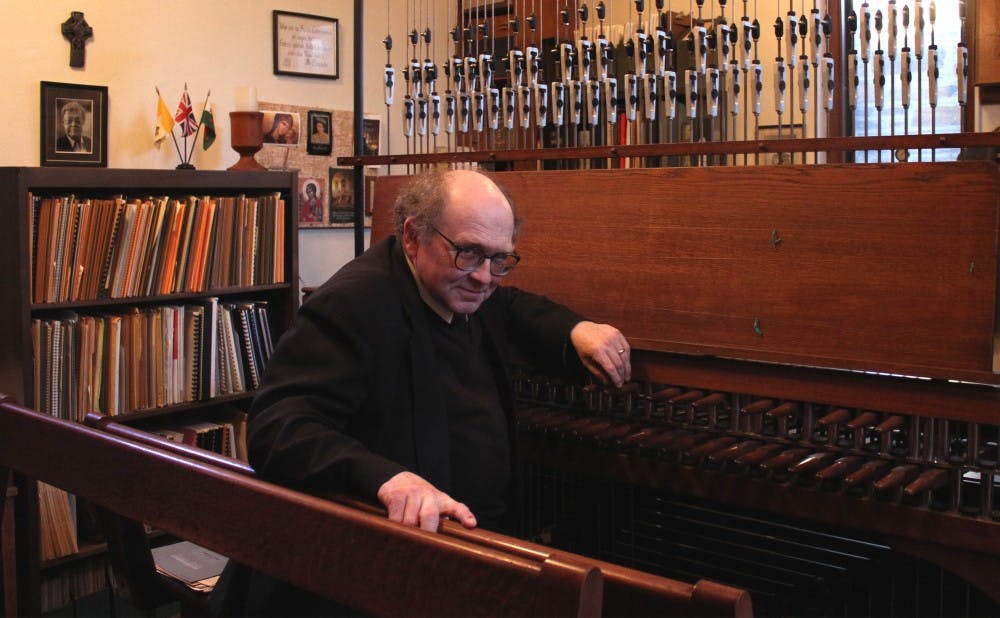When the sun is shining just right, you can usually see the bells in the steeple of the Chapel.
But the set of bells, known as a carillon, aren’t the only thing in the top of Duke’s most iconic building. Right below them sits a small office with sheet music, the bell ringing apparatus and J. Samuel Hammond, who plays the carillon every weekday at 5 p.m.
“It was something I thought I would do for the rest of my undergraduate years, but I just never left,” said Hammond, who began playing under the mentorship of a graduate student when he arrived as a first-year student at Duke in 1964.
Hammond received an undergraduate degree in history from Trinity College of Arts and Sciences in 1968 and a Masters degree in theological studies from the Duke Divinity School in 1996.
Though he initially intended to study the organ while a student, Hammond quickly fell in love with the carillon, which he says is unlike any other instrument.
“The carillon is so entirely different from any other keyboard or other type of instrument that the technique of playing the organ or piano is in and of itself not of much use,” Hammond said.
Though the carillon is controlled by giant wooden keys, it is more like a percussion instrument in the way it functions. When hit with closed fists, the wooden keys pull metal cables which run through the ceiling of the carillon room to the bells themselves, where iron clappers are pulled to ring the bell.
“It’s completely mechanical,” Hammond said. “We’ve got electric lights, but there’s nothing about the instrument that is electric at all. Both the playing and the generation of the sound is mechanical and quite natural. It is, in design, a very primitive instrument, which is one of the things that makes it a pleasure to play because there’s not much between the player and the actual maker of the sound.”
There are 50 brass bells in total, with the smallest weighing in at roughly 10 pounds and the largest weighing more than five tons. The complete set of bells, combined with the frame, weigh more than 50 tons in total. The bells were cast in England by the John Taylor Bellfounders, who have been making carillons since the 14th century. In 1992, the carillon mechanism was deconstructed and renovated to ensure the continued functionality of the bells.
"The bells are exactly the same as were put in in 1932, but the playing mechanism was replaced," Hammond said. "The first few weeks of playing it after the restoration was musically a high point, because it was a quantum leap in the way it played and sounded."
Everyday, Hammond pulls several pieces of music from the Chapel’s carillon repertoire, which fills a bookcase and a file cabinet in Hammond’s office. The office also contains a smaller practice bell set. The style of music varies throughout the year, Hammond noted.
“I try as best I can to follow the church year, but if there are other occasions for which there is some musical way to take note of them—say Valentine’s Day or the Fourth of July—and if I’ve got the wit to know of a piece of music which would be suitable, I’ll try to include that,” Hammond said.
In addition to the Duke Chapel’s carillon, Hammond has played carillons throughout the country. He also plays a recital at the University of the South in Sewanee, Tenn. most summers.
“Every instrument is different, even if its made by the same foundry in the same year," Hammond said. "It’s an enriching and sometimes challenging experience [to play other carillons] because there’s no standard size for a carillon, so you have to know and be able to adjust what you’re going to do."
Fortunately, the upcoming renovations to the Chapel will not affect the playing schedule of the carillon, he says.
“The restoration work is all taking place in the knave of the Chapel, and, as far as I know, there’s no work planned on the tower,” Hammond said. “I’ve been told that I’ll still have access because the building will closed to everybody, but they were willing to make an exception so that we can pretend that everything is normal.”
Get The Chronicle straight to your inbox
Signup for our weekly newsletter. Cancel at any time.

